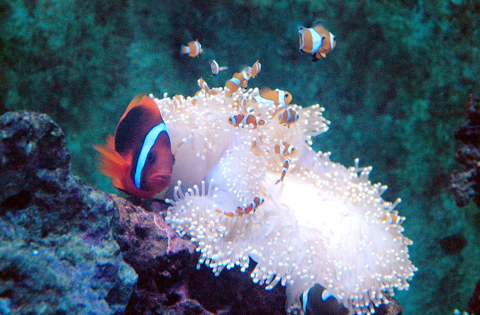A Taiwanese saltwater ornamental fish research team is working to unlock some of the mysteries surrounding the fish’s breeding process and hopes that by sharing the technology, the clownfish trade will emerge as another success story in Taiwan’s aquaculture industry, following in the footsteps of advances made in raising shrimp and grouper.
The research team estimates that by 2011, Taiwan could breed 2 million clownfish and generate NT$100 million (US$3 million) in the lucrative ornamental fish market, while helping save the species in the wild.
The team is led by Ho Yuan-hsing (何源興), an associate researcher with the Fisheries Research Institute of the Eastern Marine Biology Research Center in Taitung County, who has been actively engaged in fish breeding programs for nearly two decades. In 1997, Ho published the world’s first report on the artificial breeding of the giant grouper (Epinephelus lanceolatus), but later turned to research on saltwater ornamental fish and edible fish like abalone because he wanted “to do something more important and that has greater influence on Taiwan.”

PHOTO: CNA
His change in interest was largely motivated by pursuing an area that few had entered because he has always wanted to be a “trailblazer,” he said.
The captive breeding of saltwater ornamental fish has a high entry threshold because of technology barriers and the difficulty of obtaining sea water, which is why an overwhelming 98 percent of saltwater ornamental fish are still caught in the sea rather than artificially bred.
Taiwan is ideally positioned, Ho said, to reverse the disturbing trend, especially for clownfish. The country’s warm weather and waters provide a perfect habitat for the prized fish, and its large fish farming population (127,000 in 2007) has traditionally excelled in the field.
“Taiwan has artificially bred the most fish species in the world,” Ho said.
Taiwan has also broken considerable ground in the development of live bait as a food source for clownfish fry, a critical advancement since finding suitable food and mass producing it is essential to the artificial breeding process.
Ho’s center inaugurated a clownfish fry production farm last November, which Ho estimated could produce 100,000 clownfish this year and potentially double that next year.
The center actually began researching clownfish in 2002, but the Fry Production Model Farm only became a reality because Ho’s team was finally able to master several core technologies.
For one, pairing the clownfish is not easy. Though clownfish are strictly monogamous, that does not mean that “they will mate automatically if a male and female are put together,” Ho said.
“We have to see to it that the two see eye to eye and will not attack each other, especially because the fish is very fierce and protective of its own territory and attacks any fish, even of its own species, that encroaches into its territory,” he said.
The farm now has 150 seed pairs, with half of them spawning.
The center also controls the spawning, Ho said. In their natural habitat at sea, clownfish lay from 500 to more than 1,000 fertilized eggs once per month, but the center has been able to get the fish to spawn twice a month.
After the eggs hatch, the next challenge is to prepare the right food for the fry, Ho said. This is a potentially difficult step because the fry are only about 0.4mm in size at birth.
The center has solved the problem by providing live bait and also micro-organisms, such as rotifers and copepods, to suit the needs of the fry. Pellet diet is only fed to the fry after they are 20 days old.
Baby clownfish are also more vulnerable to disease in the winter when the water temperature is low, and the center will install a water heating system this year to solve the problem.
“Clownfish could be one of the easiest fish species to breed if you can master those core technologies,” Ho said.
Having mastered the process, the center plans to hand these technologies and the planning and management of the farm model to 10 selected breeders next year, and Ho estimates that the breeders will each be able to produce 200,000 clownfish and generate NT$10 million in revenue annually.
The many years of research by Ho’s team also culminated in the opening last month of the world’s first aquarium devoted solely to clownfish adjacent to the center.
The Aquarium of Anemonefish will soon house the center’s basic clownfish breeding program as it recently has shifted its focus to raising ornamental fish with added value, concentrating on two new approaches, Ho said, adding that one involves breeding “hybrid” species while the other emphasizes selecting unique fish within the same species, such as those with more exotic or brighter patterns, and trying to reproduce them after repeated trials.
Andrew Fang (方祖豪), executive director of saltwater ornamental fish exporter Taikong Co, said saltwater ornamental fish are more prized than freshwater species because of their bright and beautiful colors, but fish harvested from the wild often succumb to weakness when kept in tanks, making them dicey commercial propositions even if they are highly sought after.
“The captive bred fish could easily make inroads into [EU] markets,” he said.

The brilliant blue waters, thick foliage and bucolic atmosphere on this seemingly idyllic archipelago deep in the Pacific Ocean belie the key role it now plays in a titanic geopolitical struggle. Palau is again on the front line as China, and the US and its allies prepare their forces in an intensifying contest for control over the Asia-Pacific region. The democratic nation of just 17,000 people hosts US-controlled airstrips and soon-to-be-completed radar installations that the US military describes as “critical” to monitoring vast swathes of water and airspace. It is also a key piece of the second island chain, a string of

A magnitude 5.9 earthquake that struck about 33km off the coast of Hualien City was the "main shock" in a series of quakes in the area, with aftershocks expected over the next three days, the Central Weather Administration (CWA) said yesterday. Prior to the magnitude 5.9 quake shaking most of Taiwan at 6:53pm yesterday, six other earthquakes stronger than a magnitude of 4, starting with a magnitude 5.5 quake at 6:09pm, occurred in the area. CWA Seismological Center Director Wu Chien-fu (吳健富) confirmed that the quakes were all part of the same series and that the magnitude 5.5 temblor was

Taiwan will now have four additional national holidays after the Legislative Yuan passed an amendment today, which also made Labor Day a national holiday for all sectors. The Chinese Nationalist Party (KMT) and Taiwan People’s Party (TPP) used their majority in the Legislative Yuan to pass the amendment to the Act on Implementing Memorial Days and State Holidays (紀念日及節日實施辦法), which the parties jointly proposed, in its third and final reading today. The legislature passed the bill to amend the act, which is currently enforced administratively, raising it to the legal level. The new legislation recognizes Confucius’ birthday on Sept. 28, the

The Central Weather Administration has issued a heat alert for southeastern Taiwan, warning of temperatures as high as 36°C today, while alerting some coastal areas of strong winds later in the day. Kaohsiung’s Neimen District (內門) and Pingtung County’s Neipu Township (內埔) are under an orange heat alert, which warns of temperatures as high as 36°C for three consecutive days, the CWA said, citing southwest winds. The heat would also extend to Tainan’s Nansi (楠西) and Yujing (玉井) districts, as well as Pingtung’s Gaoshu (高樹), Yanpu (鹽埔) and Majia (瑪家) townships, it said, forecasting highs of up to 36°C in those areas